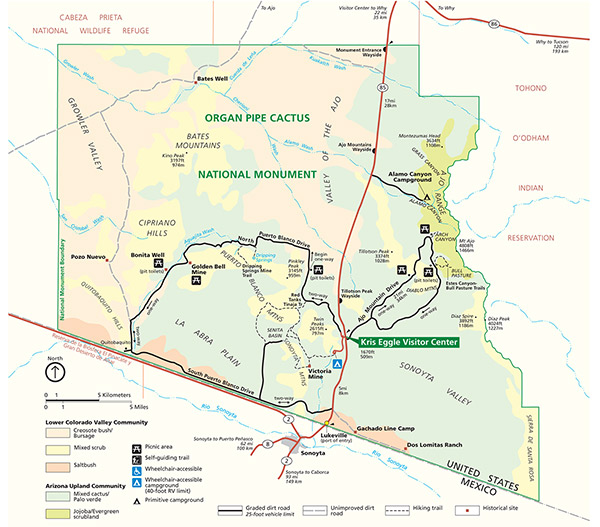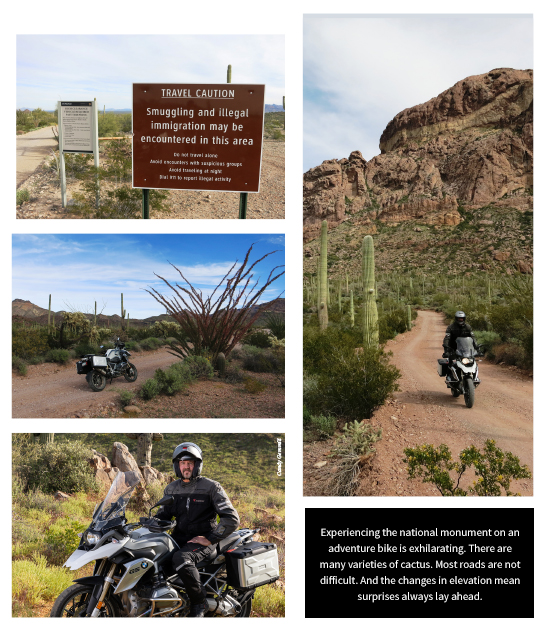AMERICAN MOTORCYCLIST MAY 2019
Brutal Beauty
Riding Organ Pipe Cactus National Monument

The national monument provides a diverse landscape. It’s not all cactus.
By Tim Kessel
Adventure riding is, by nature, a powerful mix of world exploration and self-discovery. Sometimes that mix inspires epic trips to exotic foreign lands.
However, ADV riding is also about finding compact adventures in places closer at hand. The latter is what I found in a recent dual sport ride within the boundaries of the oft-troubled, but visually stunning Organ Pipe Cactus National Monument.
My interest in Organ Pipe began when a riding buddy lent me Luis Alberto Urrea’s book, The Devil’s Highway, a powerfully crafted account of a tragically failed human-smuggling attempt at the southern Arizona border. It resulted in 14 deaths in 2001.
Organ Pipe and the Cabeza Prieta Wilderness are more than the narrative’s setting; the region unfolds as a powerful character in the book.

Human- and drug-smuggling violence in the area became so pervasive that the park was closed in 2003, and it was saddled with the ominous label of “the most dangerous national park”
by law enforcement officials. When it was recently reopened to the public, I knew I had to explore the dirt roads in Organ Pipe and see this dichotomous region for myself.
My staging point for the ride was the remote southern Arizona town of Ajo. After a great night’s sleep in a beautifully converted historic schoolroom at the Sonoran Desert Inn and Conference Center, I geared up and headed toward the Mexican border. The early morning ride south was a mind-clearing warm up.
Loop 1: Puerto Blanco
My first stop at Organ Pipe was the Kris Eggle Visitor Center.
The facility is named for a national park ranger who was shot and killed in the line of duty in the park while pursuing fleeing members of a drug cartel in 2002. This was another of the many violent and tragic events that led to the park’s closure.

Barrels of water were scattered around the park to help people making their way through the rough terrain
I picked up a park map and discussed current conditions with rangers. After checking my tires, fuel, drinking water and repair supplies, I headed out on the counterclockwise route of the 37-mile Puerto Blanco loop.
After I passed the signs warning of the potential for dangerous illegal activity in the area, Puerto Blanco started out as an undulating, paved road. Within a mile or so, the paving became intermittent.
When the asphalt ended for good, the adventure really began.
The vast array of cactus species seemed bigger than life. Towering saguaros, prickly pears, chollas and the monument’s namesake, organ pipes, combined for a truly amazing desert display. It was peering through that cornucopia of thorny vegetation that I spotted the first of what would prove to be many blue barrels resting beneath tall flags in the park. On closer inspection, those barrels carried the indication, “Humane Borders – AGUA / WATER.”
As the road became increasingly rocky and winding, I rolled up on a series of abandoned mines, an old corral and various languishing historic structures. I was struck by the fact that I had not seen another soul on the first half of the ride. The extreme western portion of the Puerto Blanco loop proved sandy enough to test the limits of my street-biased dual sport tires. I wallowed and fought, but kept my big BMW GS upright as I rode to the Mexican border.
The last dozen or so miles of Puerto Blanco was a relatively straight and intermittently sandy ride that paralleled the international border barricades. At times, Mexican dwellings and businesses were a mere stone’s throw away. The first sign of human life I found on the entire loop was a border patrol agent in a 4X4 truck sitting in a ravine. I waved and rolled along.

Loop 2: Ajo Mountain
After a short ride back toward the main entrance to the park, I made the turn to the east onto the 21-mile, clock wise, one-way loop that climbs into the Little Ajo Mountain Range. The same ominous warning signs greeted me at the start of this portion of my figure-eight trek.
Just miles into the ride, it became clear that the array and size of the cacti on this loop were even more impressive than those I experienced on Puerto Blanco.
The road on the Ajo Mountain loop was also much less challenging than the earlier leg.
The quick ascent into rocky Ajo Mountains framed impressive views in my rearview mirrors. Frequent stops brought those views into full panorama.
After rounding a particularly rough dirt curve, a stone arch in the distant mountain popped into view in the afternoon light. That arch became my focal point as it grew for the next several miles.
I parked at the trailhead of Arch Canyon, enjoyed the view and did some overdue hydrating and ate some jerky. The rest of the ride on the Ajo Mountain loop was a continuation of breathtaking views and countless acres of otherworldly stands of cacti.
After 60 miles and a very long day in the southern Arizona dirt, I headed away from the duality that is Organ Pipe Cactus National Monument. The region’s notorious past sits in stark juxtaposition to its staggering beauty. One can only hope that the sublime continues to eclipse the savage.
Tim Kessel is an AMA member from Clarkdale, Ariz.

